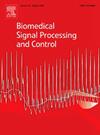Complex network properties analysis of upper trunk muscle fatigue in firefighters carrying self-contained breathing apparatus
IF 4.9
2区 医学
Q1 ENGINEERING, BIOMEDICAL
引用次数: 0
Abstract
Muscle fatigue is a significant risk factor for injuries among firefighters in the workplace, particularly when wearing self-contained breathing apparatus (SCBA) for prolonged periods. However, the mechanisms of muscle function in both non-fatigue and post-fatigue states remain unclear. The purpose of this article is to assess the effect of SCBA on muscle fatigue and compensation in firefighters using surface electromyography (sEMG) from the upper trunk muscles. Thirty volunteer firefighters were recruited to perform a running task on a treadmill, and sEMG signals were recorded from the upper trunk muscles during the initial and final phases of the task. Then, the coherence features of the beta segment (14–30 Hz) were extracted to construct the muscle functional network. Finally, differences in muscle function between the two fatigue states were assessed quantitatively by extracting muscle network parameters. The results showed that fatigue increases the functional connectivity and coupling strength between muscles during firefighters’ running with the SCBA. Compared to the non-fatigued state, muscle functional network parameters—such as clustering coefficients, global efficiencies, and small-world properties—were significantly reduced in the post-fatigued state, with decreases of approximately 36.3 %, 14.63 %, and 43.44 %, respectively. Meanwhile, the main active muscles shifted from the waist to the abdominal muscles. These findings provide a scientific basis for the development of training programmes for specific muscle groups and the optimal design of SCBA.
携带自给式呼吸器消防员上肢肌肉疲劳的复杂网络特性分析
肌肉疲劳是消防员在工作场所受伤的重要危险因素,特别是长时间佩戴自给式呼吸器(SCBA)时。然而,非疲劳状态和疲劳后状态下肌肉功能的机制尚不清楚。本文的目的是评估SCBA对消防员肌肉疲劳和补偿的影响,使用上躯干肌肉的表面肌电图(sEMG)。研究人员招募了30名志愿消防员,让他们在跑步机上完成一项跑步任务,并在任务的开始和结束阶段记录上肢肌肉的肌电信号。然后,提取β段(14 ~ 30 Hz)的相干特征,构建肌肉功能网络。最后,通过提取肌肉网络参数,定量评估两种疲劳状态下肌肉功能的差异。结果表明,疲劳增加了消防员与SCBA一起跑步时肌肉之间的功能连通性和耦合强度。与非疲劳状态相比,肌肉功能网络参数(如聚类系数、全局效率和小世界特性)在疲劳后状态下显著降低,分别降低约36.3%、14.63%和43.44%。同时,主要活动肌肉从腰部转移到腹部肌肉。这些发现为特定肌肉群训练方案的制定和SCBA的优化设计提供了科学依据。
本文章由计算机程序翻译,如有差异,请以英文原文为准。
求助全文
约1分钟内获得全文
求助全文
来源期刊

Biomedical Signal Processing and Control
工程技术-工程:生物医学
CiteScore
9.80
自引率
13.70%
发文量
822
审稿时长
4 months
期刊介绍:
Biomedical Signal Processing and Control aims to provide a cross-disciplinary international forum for the interchange of information on research in the measurement and analysis of signals and images in clinical medicine and the biological sciences. Emphasis is placed on contributions dealing with the practical, applications-led research on the use of methods and devices in clinical diagnosis, patient monitoring and management.
Biomedical Signal Processing and Control reflects the main areas in which these methods are being used and developed at the interface of both engineering and clinical science. The scope of the journal is defined to include relevant review papers, technical notes, short communications and letters. Tutorial papers and special issues will also be published.
 求助内容:
求助内容: 应助结果提醒方式:
应助结果提醒方式:


